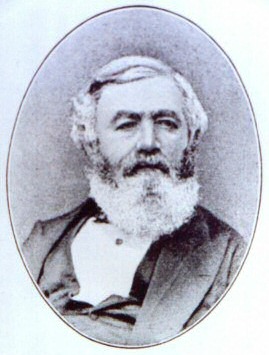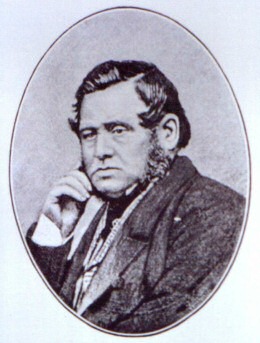|
H.W.F Bolckow
Henry William Ferdinand Bolckow, originally Heinrich Wilhelm Ferdinand Bölckow, (8 December 1806 – 18 June 1878) was a Victorian industrialist and Member of Parliament, acknowledged as being one of the founders of modern Middlesbrough. In a lifelong partnership with John Vaughan, Bolckow set up and ran an ironmaking business which became the company Bolckow Vaughan. It came to operate coal mines, limestone quarries and a major ironworks which stimulated the growth of Middlesbrough. Bolckow became the town's Mayor and its first Member of Parliament. Biography Early life Heinrich Bölckow, the son of Heinrich Bölckow of Varchow, in the region of Western Pomerania, and his wife, Caroline Duscher, was born at Sülten in the Duchy of Mecklenburg-Schwerin. When he was fifteen his parents placed him in a merchant's office in nearby Rostock, to learn about commerce, and there he made the acquaintance of Christian Allhusen, who in 1827 invited him to move to Newcastle upon Tyne ... [...More Info...] [...Related Items...] OR: [Wikipedia] [Google] [Baidu] |
Bolckow Vaughan
Bolckow, Vaughan & Co., Ltd was an English ironmaking and mining company founded in 1864, based on the partnership since 1840 of its two founders, Henry Bolckow and John Vaughan. The firm drove the dramatic growth of Middlesbrough and the production of coal and iron in the north-east of England in the 19th century. The two founding partners had an exceptionally close working relationship which lasted until Vaughan's death. By 1907 Bolckow, Vaughan was possibly the largest producer of pig iron in the world. The firm failed to modernise at the start of the 20th century, and was closed in 1929. History Origins, 1840–51 In 1840, Henry Bolckow (1806–1878) and John Vaughan (1799–1868) set up in business in Middlesbrough to make iron. They lived side by side in two town houses, the Cleveland Buildings, about away from their ironworks which were on Vulcan Street, and they married a pair of sisters, which may explain their close friendship. In 1846, Bolckow and Vaughan bui ... [...More Info...] [...Related Items...] OR: [Wikipedia] [Google] [Baidu] |
Blast Furnaces
A blast furnace is a type of metallurgical furnace used for smelting to produce industrial metals, generally pig iron, but also others such as lead or copper. ''Blast'' refers to the combustion air being "forced" or supplied above atmospheric pressure. In a blast furnace, fuel ( coke), ores, and flux (limestone) are continuously supplied through the top of the furnace, while a hot blast of air (sometimes with oxygen enrichment) is blown into the lower section of the furnace through a series of pipes called tuyeres, so that the chemical reactions take place throughout the furnace as the material falls downward. The end products are usually molten metal and slag phases tapped from the bottom, and waste gases (flue gas) exiting from the top of the furnace. The downward flow of the ore along with the flux in contact with an upflow of hot, carbon monoxide-rich combustion gases is a countercurrent exchange and chemical reaction process. In contrast, air furnaces (such as reverberator ... [...More Info...] [...Related Items...] OR: [Wikipedia] [Google] [Baidu] |
Bessemer Process
The Bessemer process was the first inexpensive industrial process for the mass production of steel from molten pig iron before the development of the open hearth furnace. The key principle is steelmaking, removal of impurities from the iron by oxidation with air being blown through the molten iron. The oxidation also raises the temperature of the iron mass and keeps it molten. Related Decarburization, decarburizing with air processes had been used outside Europe for hundreds of years, but not on an industrial scale. One such process (similar to puddling (metallurgy), puddling) was known in the 11th century in East Asia, where the scholar Shen Kuo of that era described its use in the Chinese iron and steel industry. In the 17th century, accounts by European travelers detailed its possible use by the Japanese. The modern process is named after its inventor, the Englishman Henry Bessemer, who took out a patent on the process in 1856. The process was said to be independently discover ... [...More Info...] [...Related Items...] OR: [Wikipedia] [Google] [Baidu] |
Municipal Corporation
A municipal corporation is the legal term for a local governing body, including (but not necessarily limited to) cities, counties, towns, townships, charter townships, villages, and boroughs. The term can also be used to describe municipally owned corporations. Municipal corporation as local self-government Municipal incorporation occurs when such municipalities become self-governing entities under the laws of the state or province in which they are located. Often, this event is marked by the award or declaration of a municipal charter. A city charter or town charter or municipal charter is a legal document establishing a municipality, such as a city or town. Canada In Canada, charters are granted by provincial authorities. India The Corporation of Chennai is the oldest Municipal Corporation in the world outside the United Kingdom. Ireland The title "corporation" was used in boroughs from soon after the Norman conquest until the Local Government Act 2001. Under the 20 ... [...More Info...] [...Related Items...] OR: [Wikipedia] [Google] [Baidu] |
Limited Liability Company
A limited liability company (LLC for short) is the US-specific form of a private limited company. It is a business structure that can combine the pass-through taxation of a partnership or sole proprietorship with the limited liability of a corporation. An LLC is not a corporation under state law; it is a legal form of a company that provides limited liability to its owners in many jurisdictions. LLCs are well known for the flexibility that they provide to business owners; depending on the situation, an LLC may elect to use corporate tax rules instead of being treated as a partnership, and, under certain circumstances, LLCs may be organized as not-for-profit. In certain U.S. states (for example, Texas), businesses that provide professional services requiring a state professional license, such as legal or medical services, may not be allowed to form an LLC but may be required to form a similar entity called a professional limited liability company (PLLC). An LLC is a hybrid le ... [...More Info...] [...Related Items...] OR: [Wikipedia] [Google] [Baidu] |
Bolckow, Vaughan
Bolckow, Vaughan & Co., Ltd was an English steelmaking, ironmaking and mining company founded in 1864, based on the partnership since 1840 of its two founders, Henry Bolckow and John Vaughan (ironmaster), John Vaughan. The firm drove the dramatic growth of Middlesbrough and the production of coal and iron in the north-east of England in the 19th century. The two founding partners had an exceptionally close working relationship which lasted until Vaughan's death. By 1907 Bolckow, Vaughan was possibly the largest producer of pig iron in the world. The firm failed to modernise at the start of the 20th century, and was closed in 1929. History Origins, 1840–51 In 1840, Henry Bolckow (1806–1878) and John Vaughan (Ironmaster), John Vaughan (1799–1868) set up in business in Middlesbrough to make iron. They lived side by side in two town houses, the Cleveland Buildings, about away from their ironworks which were on Vulcan Street, and they married a pair of sisters, which may ... [...More Info...] [...Related Items...] OR: [Wikipedia] [Google] [Baidu] |





